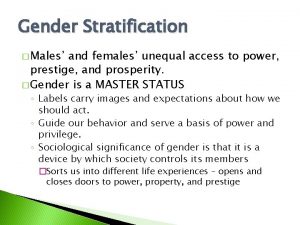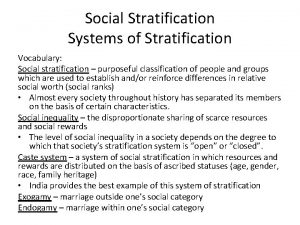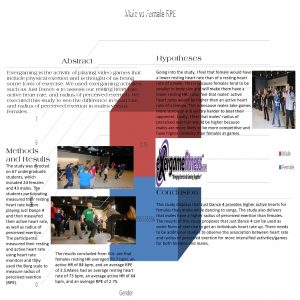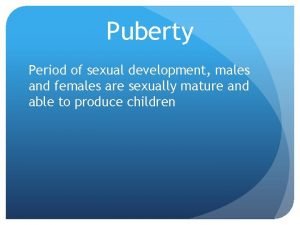Gender Stratification Males and females unequal access to

















- Slides: 17

Gender Stratification � Males’ and females’ unequal access to power, prestige, and prosperity. � Gender is a MASTER STATUS ◦ Labels carry images and expectations about how we should act. ◦ Guide our behavior and serve a basis of power and privilege. ◦ Sociological significance of gender is that it is a device by which society controls its members �Sorts us into different life experiences – opens and closes doors to power, property, and prestige

Sex and Gender � Sex: biological characteristics that distinguish males and females. ◦ Primary Sex Characteristics: vagina or penis and other organs related to reproduction. ◦ Secondary Sex Characteristics: physical distinctions between males and females not directly connected with reproduction. �Become evident during puberty �Males = muscles, lower voice, body hair, and height �Females = fatty tissue and broader hips, and breasts � Gender: behaviors and attitudes a group considers proper for its males and females ◦ Social, not biological ◦ Inherit your sex, but learn your gender (socialized)

Differences in Behavior � Does biological difference control our behavior? ◦ Does it make females more nurturing and submissive and males more aggressive and domineering? � Our visible differences of sex do not come with meanings built into them ◦ Each human group makes its own interpretations of these physical differences and on this basis assigns males and females to separate groups – people learn what is expected. � If biology were the principal factor, all around the world we would find women to be one sort of person and men another. ◦ Ideas of gender, however, vary greatly from one culture to another and so do male-female behaviors

Biology has some say… � Biological factors are involved in some human behavior other than reproduction and childbearing. ◦ Women are better prepared biologically for “mothering” than are men. �More sensitive to the infant’s soft skin and to their nonverbal communications. ◦ Nature provides biological predispositions, which are then overlaid with culture. �Issue is not biology or society.

Biology versus Culture - Culture � Differences are the result of social factors ◦ Hunting and gathering societies - the roles of both women and men are less rigid than those created by stereotypes – separate but equal status of women at this level of development. ◦ Types of work are created by social arrangements – informal customs and formal laws enforce it (barriers removed = women’s work habits are similar to men’s) ◦ Rising female crime rates – aggression is related to social factors and not biology. � Social factors – socialization, gender discrimination, and other forms of social control – create gender differences in behavior.

Biology versus Culture - Biology � Inborn differences that “give masculine and feminine direction to the emotions and behaviors” ◦ Men dominate because they have a lower threshold for elicitation of dominance behavior… greater tendency to exhibit whatever behavior is necessary to attain dominance in hierarchies and male-female encounters. ◦ Men are more willing “to sacrifice the rewards of other motivations –the desire for affection, health, family life, safety, relaxation, etc. – to attain dominance. � Medical Accident

Different Cultures � Tunisia Prostitution � China – bride selling � Japan – Beauty/Pain in Advertising � Africa – Female Circumcision

Gender Gap � Boys’ reading achievement consistently lags behind girls’ as students get older. � Fewer boys than girls now study advanced algebra, geometry, and chemistry. � 42% of college students are male. � Boys earn 70% of report card D’s and F’s and are 50% more likely to be retained; 71% of school suspensions; 83% of students labeled ADD or ADHD � 3 -5 times more likely to be labeled learning disabled. � Boys outnumber girls in high school sports, but girls greatly outnumber boys in every other extracurricular activity.

Gender Gap continued… � Boys are more likely to express strong dislike for school. � Boys seldom find their work to be “meaningful or important” � Only 66% of male high school seniors say they will “definitely graduate from a 2 -4 year college. ” � Girls take 54% of AP exams (continuing to grow) � 82% of females say they will “definitely graduate from college”

Differences in the Male/Female Brain � Processing: ◦ Language Processing Areas ◦ Spatial Processing Areas ◦ Sensory System � Chemical: ◦ ◦ ◦ Testosterone Estrogen Serotonin Dopamine Oxytocin

Male and Female Hemisphere Dominance � Left Hemisphere dominance is more common in females (logical, analytical, objective). � Right Hemisphere dominance is more common in males (intuitive, thoughtful, subjective). � Although our brains function at times using both hemispheres, schools are traditionally designed to be more left hemisphere friendly. ◦ Structured with time periods and ringing bells, organized around facts and rules, rely primarily on verbal processing, limit access to space and movement, require a lot of multitasking.

Classroom Strategies to Benefit Boys and Girls � Movement ◦ Physically, mentally, and emotionally “clumsy” in gender-specific ways. ◦ When learning is paired with movement, learning is anchored in the body through procedural memory. ◦ Increases motivation ◦ Boys generally need more movement than girls – keeping the brain stimulated and controlling impulsive behavior. ◦ Increases blood flow/neurotransmitters helping boys learn new concepts better, retain them longer, and cause less distraction.

Strategies continued… � Learning Teams of Boys and Girls ◦ Girls tend to do more overall processing during group work than boys – more concerned about seeing that everyone is included/picking a leader. Also taking in more opinions during a task (naturally break into groups of 3 or 4) ◦ Boys find this style boring. �Become more highly engaged in learning when there is an edge of competition to a project (stimulates reward centers of the brain). ◦ Gender-specific groups allow more clear instruction than co-ed groups – avoid the adolescent hormone -charged “mating behaviors.

Strategies continued… � Relevance matters ◦ Students care more about learning when it can be connected to real life and real purposes. ◦ Generally girls are more willing to do things simply to please their teacher. ◦ Central partners in learning = learning improves �Find student interests, motivations, passions, and talents (intrinsic motivations) ◦ Social capital or “getting cool with your friends” is a powerful motivation for adolescents

Do Split-Gender Classes Really Work? � Do you prefer single-gender or mixed-gender classes? ◦ Single-Gender: � Boys – 72% � Girls – 62% ◦ Mixed-Gender: � Boys -28% � Girls – 38% � In which do you find it easier to concentrate? ◦ Single-Gender: � Boys – 76% � Girls – 75% ◦ Mixed-Gender: � Boys -24% � Girls – 25% � In which do you feel more successful? ◦ Single-Gender: � Boys – 83% � Girls – 74% ◦ Mixed-Gender: � Boys -17% � Girls – 26%

Do Split-Gender Classes Really Work? � I feel that I have improved my behavior at school in a single-gender class: ◦ Boys: 83% ◦ Girls: 78% � I have improved my self-confidence in a single-gender class: ◦ Boys: 76% ◦ Girls: 69% � I have increased my desire to succeed in school in a single -gender class: ◦ Boys: 89% ◦ Girls: 70% � I am earning grades that I am proud of in a single-gender class: ◦ Boys: 85% ◦ Girls: 74%

Journal Question – DUE WEDNESDAY � In a page Journal: ◦ Based on what you know about the differences between boys and girls (both in “doing gender” – including the pressures in doing so – and in the education setting), what do you think is the best learning environment – single-sex or co-ed – and why? �Use details from your own experiences, the notes, and our class discussions to help answer this question.
 The unequal access of males and females to property
The unequal access of males and females to property Meioss
Meioss Gender stratification
Gender stratification Strategic gender needs and practical gender needs
Strategic gender needs and practical gender needs Why is access to folk and popular culture unequal
Why is access to folk and popular culture unequal How many immature eggs are females born with
How many immature eggs are females born with Klinefelter's disease
Klinefelter's disease Eer equation
Eer equation 3 inappropriate dress items for fbla
3 inappropriate dress items for fbla Site:slidetodoc.com
Site:slidetodoc.com Puberty stage 1
Puberty stage 1 Adrenarche age 7
Adrenarche age 7 Nageeb thought all nurses were young females
Nageeb thought all nurses were young females Types of thyroid
Types of thyroid Characteristics of helminths
Characteristics of helminths In 1971 there were 294 105 females
In 1971 there were 294 105 females High prolactin levels symptoms
High prolactin levels symptoms Proper use of ffa jacket
Proper use of ffa jacket

































